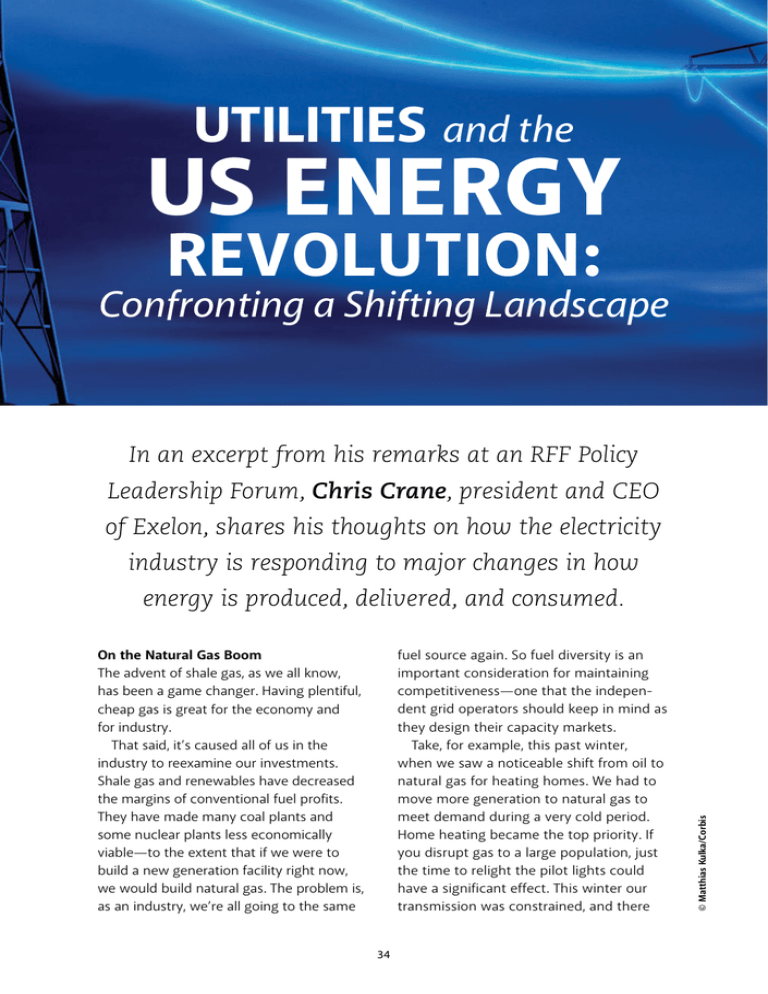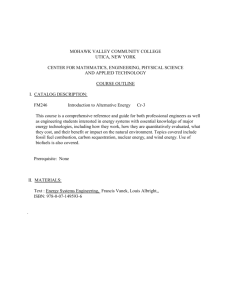US ENERGY REVOLUTION: UTILITIES
advertisement

UTILITIES and the US ENERGY REVOLUTION: Confronting a Shifting Landscape In an excerpt from his remarks at an RFF Policy Leadership Forum, Chris Crane, president and CEO of Exelon, shares his thoughts on how the electricity industry is responding to major changes in how fuel source again. So fuel diversity is an important consideration for maintaining competitiveness—one that the independent grid operators should keep in mind as they design their capacity markets. Take, for example, this past winter, when we saw a noticeable shift from oil to natural gas for heating homes. We had to move more generation to natural gas to meet demand during a very cold period. Home heating became the top priority. If you disrupt gas to a large population, just the time to relight the pilot lights could have a significant effect. This winter our transmission was constrained, and there On the Natural Gas Boom The advent of shale gas, as we all know, has been a game changer. Having plentiful, cheap gas is great for the economy and for industry. That said, it’s caused all of us in the industry to reexamine our investments. Shale gas and renewables have decreased the margins of conventional fuel profits. They have made many coal plants and some nuclear plants less economically viable—to the extent that if we were to build a new generation facility right now, we would build natural gas. The problem is, as an industry, we’re all going to the same 34 © Matthias Kulka/Corbis energy is produced, delivered, and consumed. expanding our business line. For example, I have spent time at the Toshiba research facility in Yokohama, Japan, learning more about how its engineers are perfecting the manufacturing and efficiency of fuel cells for the residential level. Researchers at Bloom Energy in San Jose, California, are doing fantastic work on their industrialscale solid oxide fuel cells, which are much larger. So technology is advancing, but we need to design a system that is reliable and fair to all consumers. Exelon is piloting a microgrid with the Illinois Institute of Technology in Chicago, and the focus of the project is on reliability. If the grid goes down, the hospitals, the University of Chicago, a very important police command center, and other critical infrastructure would isolate from the grid, and the distributed generation would pick up and run. That’s a neat concept. It’s all about reliability and security. There is a defense mechanism in there, but at the end of the day, that customer base still needs to be attached to a larger grid to provide economic-scaled generation. were natural gas plants—including some of our own—that failed to meet demand. As a result, there was a dependency on some of the old coal units that are about to retire to be able to meet the load during that period. By contrast, if we load the core of a nuclear plant and fuel it to run 18–24 months, it does not matter what the weather is like outside—that plant runs, so it’s highly reliable. It can support the needs of the grid in stress periods. I think the market design must compensate assets for their capability around that. If a natural gas plant has a dual-fuel mix with oil storage to meet those peak capacity needs, it should have a compensation mechanism. On Renewables and Distributed Energy Exelon has a small distributed generation business. It is a customer-facing product that we offer to our larger industrial customers who receive gas and electricity now, but if they want solar panels, we will install them. We also are doing a deep evaluation of fuel cells, as we look at potentially 35 Steam vents from a cooling tower at Exelon's Limerick Generating Station, one of its 10 nuclear power plants. On the Future of Nuclear Looking forward, we predict long-run natural gas will cycle between $4 and $6 per million British thermal units. As prices come down, development will slow. As prices 36 © Exelon Corp. a family has a 200-amp service entrance on their house, that utility distribution system needs to be designed to provide them 200 amps at any instantaneous moment they want. Just because they install a solar panel does not mean they are disconnecting from the grid. There’s a dependency, but there should be an enabling on the grid to allow for solar, and the consumer should be compensated at the wholesale price of energy. On Subsidies and Customer Choice People should have choice, but it should be understood that we cannot continue to subsidize everything. When customers want to have a microgrid, that should be facilitated for them within the regulatory framework and the utility’s suite of products that they offer. Consumers can then decide from there. Likewise, if you put a solar panel on your roof, that is your choice. If you have excess power and want to sell that power back to the grid, that’s fantastic for the grid, but what has to happen to enable that? The design of the local distribution system has to handle the voltage fluctuations. Every customer has a specific service capacity. If costs. We all employ paramilitary forces at our sites who are true professionals, and fulfilling critical technology requirements is very expensive. come back up, they will spur more development. Significant seasonal differences could break through that swing, but they will be momentary. The majority of our nuclear fleet can compete in that range, but there are exceptions. We have a few units that are small in size but require the same security force as our larger units, carrying a much greater On the Prospects for Modular Reactors Looking a decade or more out, I predict the focus will shift to small, efficient modular reactor designs. These reactors can be In response to shifts in the US energy landscape, a polarizing debate is taking place in the industry. Wind is arguing against nuclear, and solar’s off on its own, arguing against the world. completely manufactured in a factory and then delivered and installed. Given support for a different regulatory regime that takes into consideration the risk associated with an accident, these modular reactors will cut down the capital cycle for the investment. If you’re building a dual-unit nuclear plant today, it costs about $16 billion, spent over eight years. Modular reactors, coupled with a smaller safety force, could cut that capital cycle down to two years, and then you would start to see a return on investment. So we are putting a lot of work in following the modular reactor design process. The Nuclear Energy Institute has taken the lead in working with government to figure out what the regulatory framework needs to be to support them. Maybe not within my career but, hopefully, in the future, we’ll start to see the modular reactors play a significant role. One other critical consideration is the uncertain future of water availability. Heat maps show us that by 2050, droughts will plague even Florida. So starting with the western states, generation technology must start to focus in on air-cooled condensers, with less dependency on water. The modu- overhead. We have to be realistic. We’re not saying we should be subsidized; nobody should be subsidized in the competitive market, so consequently a few units might not make it. We are retiring a preannounced facility, Oyster Creek, in New Jersey in 2019. It’s a struggling unit today, and we continue to evaluate its performance. The other units that are challenged are larger, more reliable, dual-unit sites that sit in transmission-constrained zones, with an oversupply on off-peak hours of wind, which is causing price suppression. So it’s very tough to compete in those environments. What both types of units have in common is they have to compete in a lower-margin environment with a higher baseline price. We are experiencing inflation in operating costs across the fleet. Fukushima is not immaterial. For instance, new seismic regimes are just coming out that require us to go back and validate our seismic spectra for the plants and the design. The cost of labor escalates at about 3 percent a year, and the supply chain has been expensive. Regulation issues have probably had the biggest impact since 2000. After 9/11, there was a significant change in our security 37 Chris Crane joined RFF President Phil Sharp at the May 13 Policy Leadership Forum for a conversation about the massive shifts affecting the energy industry. How do you have complementary design systems? Solar is a complementary design to a base-load nuclear plant. As the sun comes up, the load starts to pick up, and solar is able to pick up that load. As the solar generation comes off, you get back down to base load. For wind generation, you figure out how to feather in enough wind and have the right amount of investment in gas as a backup. Renewables need to be backed up with a carbon-based source. There’s no getting around it right now. The technology is not advanced enough to make an economic storage system. That may change in coming years, in which case carbon-based electricity will be a transition source. But the lar reactors lend themselves to the utilization of that technology much better than a large-scale generation facility. On Taking an All-of-the-Above Approach In response to shifts in the US energy landscape, a polarizing debate is taking place in the industry. All of us with commercial interests are stating our opinion. Nuclear is arguing against wind. Wind is arguing against nuclear, and solar’s off on its own, arguing against the world. It would be much more constructive if we could come to the table with policymakers and demonstrate the benefits of an all-of-theabove clean stack, along with the economic advantages each one can provide. 38 designs but also provide an opportunity for more states to participate together. Many states are net importers of generation and will have a much more difficult time meeting the goals of 111(d) without combining into a regional greenhouse gas scenario. Other states, such as Illinois, would be greatly challenged to meet a greenhouse standard if nuclear plants start to retire. Getting all the players together to assess the requirements of each asset that needs to stay in the stack to meet the goals would be greatly beneficial. © Resources for the Future demise of central-station power and utility distribution systems is overstated at this point. Getting to the table and designing a future together is a much more productive way to go. On New Carbon Regulations I believe that if there is a push to change the emissions profile of the US generating sector, it either should be through legislation or regulation. The Obama administration now seems to be going the regulation route, with the Clean Air Act Section 111(d) rules for reducing emissions at existing power plants, which direct the states to have their own profiles on carbon reduction. That could go a long way toward individual state Video footage of the May 13, 2014, RFF Policy Leadership Forum, “Energy Revolution: Utilities Confront the Shifting Energy Landscape,” is available at www.rff.org/ energyrevolution. 39


